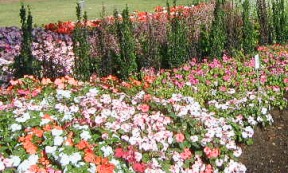Breaking Ground 8
About Ficus in the Interior
by Derek Burch

I'm not sure whether the interior landscape industry is in strong enough
condition now to be the engine that drives what is grown by nurseries,
but commercial installers are probably still an important buying segment.
They have definitely set the stage for what is now offered to homeowners
by garden centers.And this is to everyone's benefit since the industry
could not afford to use plants that would not be easy to keep in good
condition. On the other hand, it has knocked out of the market some interesting
plants that took a little extra care.
There was a time in the 70s when specifying a tree in an atrium automatically meant using Ficus benjamina. Research had established optimum nutrition and shade levels for production; beautiful specimens were available, in almost any quantity and size, and the speed with which they grew in the nursery made it difficult to get other trees at a competitive price. Quite a success story for a tree species which had an ugly reputation among interiorscapers for its appalling habit of dropping leaves at the slightest (some claimed no) provocation. The industry learned how to ship the trees, and the interiorscapers educated their customers, developing a series of (mostly true) explanations for problems that developed ("must be the season," "did you have the air conditioning off?" and so on).
Other trees came into the picture, including other ficus, but still regular old benjaminas remained grudgingly a mainstay of the industry. The picture began to change in the late 80s. Variations, an odd leaf shape or a different flower, show up in large populations of almost any plant, and ficus are no exception. Keen-eyed nurserymen selected and propagated many of these, and the best of them have survived extensive testing and reselection to produce a range of varieties that have outstanding qualities as plants for the interior. Sudden leaf drop has been essentially eliminated under normal conditions, the plants will thrive under light levels as low as 150 foot candles with a 10-12 hour day, and the aesthetics of the plant - leaf color and gloss and density of branching- have all received attention.
Some of the very best are patented in the US or have breeder rights protection, and are marketed with protected brand names so that consumers are assured what they are buying. They are a superb example of upgrading what had become a "commodity" item into a premium product. If you have come across any discussion of brand names for plants, this is one of the success stories that the industry loves. It has shown that the work and expense of selection and testing, and the hassle of registering a plant can pay off in everything from consumer satisfaction to improved profitability all the way down the producer/retailer chain.
Please excuse this diversion about how the industry works. I know that it will not be of interest to everyone, but it is a reminder that there is a multitude of people out there who are very serious about growing plants, and whose livelihood depends on being serious. Knowing this, and knowing the people, is one of the reasons why I am so often rude in speech and print about the retailers who don't do their part in getting plants to the people in good shape and with instructions on how to make them thrive. Blame me for an excess of zeal, but well-grown plants deserve to be passed on to their final homes with the best possible chance of spreading the joy that is their nature.
Back to Table of Contents